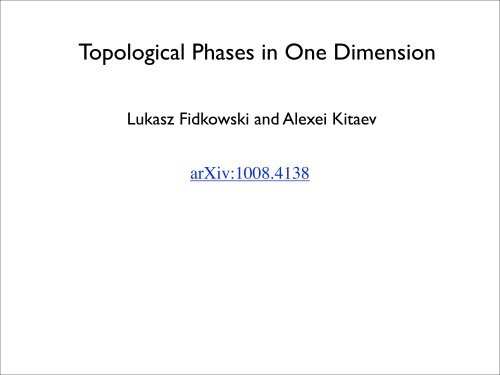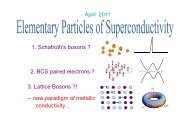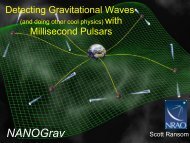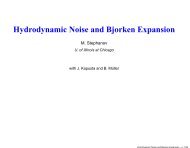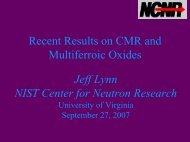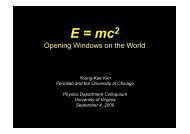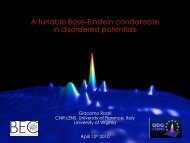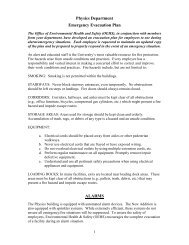Topological Phases in One Dimension
Topological Phases in One Dimension
Topological Phases in One Dimension
Create successful ePaper yourself
Turn your PDF publications into a flip-book with our unique Google optimized e-Paper software.
<strong>Topological</strong> <strong>Phases</strong> <strong>in</strong> <strong>One</strong> <strong>Dimension</strong><br />
Lukasz Fidkowski and Alexei Kitaev<br />
arXiv:1008.4138
<strong>Topological</strong> phases <strong>in</strong> 2 dimensions:<br />
- Integer quantum Hall effect<br />
- quantized σ xy<br />
- robust chiral edge modes<br />
- Fractional quantum Hall effect<br />
- fractionally charged quasi-particles<br />
- robust chiral edge modes<br />
- Quantum sp<strong>in</strong> Hall, topological <strong>in</strong>sulators, etc.<br />
- free electrons, sp<strong>in</strong>-orbit coupl<strong>in</strong>g
The Majorana Wire<br />
- sp<strong>in</strong>-less p-wave superconductor<br />
- tight-b<strong>in</strong>d<strong>in</strong>g model:<br />
j =<br />
1 2 3 4 5 6<br />
(µ a † j a j + t(a j a † j+1 + a j+1a † j ) + ∆(a ja j+1 + a † j a† j+1 ) )<br />
H = ∑ j<br />
chemical<br />
potential<br />
hopp<strong>in</strong>g<br />
pair<strong>in</strong>g
Gapped Hamiltonians:<br />
“trivial” phase<br />
“topological” phase:<br />
protected Majorana<br />
edge modes<br />
phase transition
Re-write <strong>in</strong> terms of Majorana modes:<br />
〈a j , a † j 〉 〈c 2j−1, c 2j 〉<br />
c 2j−1 = −i(a j + a † j )<br />
c 2j = a j + a † j<br />
{a 1 , . . . , a N , a † 1 , . . . , a† N } {c 1 , . . . , c 2N }<br />
N fermion creation /<br />
annihilation operators<br />
2N Hermitian Majorana<br />
operators
- our Hamiltonian can then be written as a quadratic<br />
form <strong>in</strong> the Majoranas:<br />
2N∑<br />
H =<br />
A mn c m c n<br />
m,n=1<br />
- graphical representation:<br />
Hilbert Space:<br />
j =<br />
1 2 3<br />
c 1 c 2 c 3 c 4 c 5 c 6
Hamiltonian:<br />
c 1 c 2 c 3 c 4 c 5 c 6<br />
= i 2 (c 1c 2 + c 3 c 4 + c 5 c 6 )<br />
= a † 1 a 1 + a † 2 a 2 + a † 3 a 3 decoupled
trivial phase:<br />
c 1 c 2 c 3 c 4 c 5 c 6<br />
topological phase:<br />
c 1 c 2 c 3 c 4 c 5 c 6<br />
dangl<strong>in</strong>g Majorana modes<br />
a = 1 2 (c 1 + ic 6 )<br />
double ground state degeneracy<br />
a † = 1 2 (c 1 − ic 6 )
Recap:<br />
It<strong>in</strong>erant sp<strong>in</strong>-less fermions <strong>in</strong> one dimension have two<br />
phases. The non-trivial “topological” one is characterized<br />
by hav<strong>in</strong>g Majorana edge modes at its endpo<strong>in</strong>ts.<br />
What is left:<br />
1) <strong>in</strong>teractions?<br />
2) symmetries?<br />
either generic (like time reversal or particle-hole) or<br />
some arbitrary symmetry group G (like SU(2) <strong>in</strong> sp<strong>in</strong><br />
cha<strong>in</strong>s)
Majorana cha<strong>in</strong> with time reversal symmetry<br />
- sp<strong>in</strong>-less fermions as before, with<br />
T :<br />
a j → a j<br />
a † j → a† j<br />
T : c k → (−1) k c k<br />
- non-<strong>in</strong>teract<strong>in</strong>g (i.e. quadratic fermion) analysis gives<br />
<strong>in</strong>f<strong>in</strong>itely many phases, characterized by an <strong>in</strong>teger n∈ Z<br />
1 2 3 4 5 6 7 8
we showed that with <strong>in</strong>teractions,<br />
down to<br />
Z 8<br />
n → n mod 8<br />
Z<br />
is broken<br />
showed this by turn<strong>in</strong>g on quartic <strong>in</strong>teractions and<br />
f<strong>in</strong>d<strong>in</strong>g an explicit path <strong>in</strong> <strong>in</strong>teract<strong>in</strong>g Hamiltonian<br />
space which connects n and n+8.<br />
But how to handle <strong>in</strong>teractions <strong>in</strong> general?
Matrix Product States:<br />
- Bosonic sp<strong>in</strong> cha<strong>in</strong>s with local local sp<strong>in</strong>s s<br />
Ψ(s 1 , . . . , s N ) = Tr(A s1 . . . A sN )<br />
s i ∈ {−s/2, −s/2 + 1, . . . , s/2}<br />
A si<br />
: D × D matrices<br />
(can be generalized to fermionic systems via Jordan-Wigner<br />
transform)<br />
- Ground states of gapped Hamiltonians can be<br />
approximated arbitrarily well by MPS with small D<br />
(Hast<strong>in</strong>gs 2006)
Tensor network contraction picture:<br />
Closed MPS:<br />
Open MPS:<br />
s 1<br />
s 2<br />
s 3 s 4<br />
s 5<br />
s 9<br />
α<br />
α β β γ<br />
s 8<br />
s 1 s 2 s 3 s 4 s 5<br />
α β β γ γ<br />
s 7<br />
s 6<br />
α, β, γ ∈ {1, . . . , D}
Virtual degrees of freedom edge modes<br />
Theorem: If G is a symmetry of the orig<strong>in</strong>al states, then G has a<br />
projective action on the virtual degrees of freedom.<br />
(projective means that group relations are obeyed only up to<br />
phases, which one might not be able to gauge away)<br />
Thus, if G is a symmetry of the Hamiltonian, then there is a<br />
projective action of G on the edge modes.<br />
Generally, there is a discrete set of classes of projective<br />
representations of G, and these classes correspond to different<br />
phases. In fact, they enumerate all gapped phases of<br />
Hamiltonians with that symmetry group.
Example: AKLT Hamiltonian for sp<strong>in</strong>-1 Heisenberg model<br />
G = SO(3), but edge states <strong>in</strong> the non-trivial (Haldane) phase are<br />
half-<strong>in</strong>teger sp<strong>in</strong>s. These are representations of SU(2), and only<br />
projective representations of SO(3).<br />
Example: Majorana cha<strong>in</strong> with time reversal symmetry<br />
G = where P = (-1)^F<br />
If n mod 8 is the previously discussed topological <strong>in</strong>dex then:<br />
- n mod 2: P bosonic vs. fermionic<br />
- n mod 4: T commut<strong>in</strong>g/anti-commut<strong>in</strong>g with P<br />
- n mod 8: T^2 = +1 or T^2 = -1


